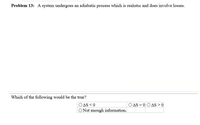
College Physics
11th Edition
ISBN: 9781305952300
Author: Raymond A. Serway, Chris Vuille
Publisher: Cengage Learning
expand_more
expand_more
format_list_bulleted
Question
thumb_up100%

Transcribed Image Text:Problem 13: A system undergoes an adiabatic process which is realistic and does involve losses.
Which of the following would be the true?
AS < 0
O Not enough information.
OAS = 0 O AS > 0
Expert Solution
This question has been solved!
Explore an expertly crafted, step-by-step solution for a thorough understanding of key concepts.
This is a popular solution
Trending nowThis is a popular solution!
Step by stepSolved in 2 steps with 2 images

Knowledge Booster
Learn more about
Need a deep-dive on the concept behind this application? Look no further. Learn more about this topic, physics and related others by exploring similar questions and additional content below.Similar questions
- Part (e) Calculate the change in the entropy of the gas in joules per kelvin.arrow_forwardWhat is the entropy change of 15 g of steam at 100°C when it condenses to water at the same temperature? ΔS=ΔS= J/K Submit QuestionQuestion 45-g of water at 14°C is heated until it becomes vapor at 100°C. Calculate the change in entropy of the water in this process. ΔS=ΔS= J/Karrow_forwardConsider a heat engine with a cycle described by the figure, with the volume and pressure at points A, B, C, and D given below. VA = 0.95 × 10-3 m3VB = 3.5 × 10-3 m3PA = 2.65 × 106 N/m2PB = 2.37 × 106 N/m2PC = 0.75 × 106 N/m2PD = 1.29 × 106 N/m2 a)Calculate the net work output, in joules, of the heat engine following path ABCDA.arrow_forward
- As shown in the figure, a chamber with a moveable piston and containing a monatomic ideal gas in an initial state A undergoes an isovolumetric, then an isothermal, and finally an isobaric process to complete the cycle. P (atm) LV (L) When the gas is in the initial state, the volume is 3.00 L, the pressure is 5.00 atm, and the temperature is 200 K. The gas is first warmed at constant volume to a pressure of 4 times the initial value (state B). The gas is then allowed to expand isothermally to some new volume (state C). Finally it is compressed isobarically to its initial state. (Due to the nature of this problem, do not use rounded intermediate values in your calculations-including answers submitted in WebAssign.)arrow_forwardCalculate the net work output of a heat engine following path ABCDA in the figure below, where V1 = 2.6 ✕ 10−3 m3 and V2 = 10.4 ✕ 10−3 m3.arrow_forwardSuppose a heat engine design makes a square on a PV diagram, using a monatomic gas. The high pressure is 3P and low pressure is P. The high volume is 3V and low volume is V. What is the efficiency of the heat engine?arrow_forward
- image464arrow_forwardAn engineer decided to design a hybrid engine half-way between the Carnot and Otto Cycles based on using 35 moles of a diatomic gas. It features (a) an adiabatic expansion for power, (b) an isothermal compression to reset, and (c) an isovolumetric temperature injection. Some of the key state values are given on the P-V chart for the transition points between the processes. What is the 1) net work performed by the engine, 2) the amount of heat injected the isovolumetric temperature increase (QH), and 3) based on these values, what is the efficiency of the engine?Solve for other state variables as necessary How much more efficient would a Carnot engine be acting between these same temperatures?arrow_forwardCalculate the change in entropy as 0.3989 kg of ice at 273.15 K melts. The latent heat of fusion of water is 333000 J/kg.arrow_forward
arrow_back_ios
arrow_forward_ios
Recommended textbooks for you
 College PhysicsPhysicsISBN:9781305952300Author:Raymond A. Serway, Chris VuillePublisher:Cengage Learning
College PhysicsPhysicsISBN:9781305952300Author:Raymond A. Serway, Chris VuillePublisher:Cengage Learning University Physics (14th Edition)PhysicsISBN:9780133969290Author:Hugh D. Young, Roger A. FreedmanPublisher:PEARSON
University Physics (14th Edition)PhysicsISBN:9780133969290Author:Hugh D. Young, Roger A. FreedmanPublisher:PEARSON Introduction To Quantum MechanicsPhysicsISBN:9781107189638Author:Griffiths, David J., Schroeter, Darrell F.Publisher:Cambridge University Press
Introduction To Quantum MechanicsPhysicsISBN:9781107189638Author:Griffiths, David J., Schroeter, Darrell F.Publisher:Cambridge University Press Physics for Scientists and EngineersPhysicsISBN:9781337553278Author:Raymond A. Serway, John W. JewettPublisher:Cengage Learning
Physics for Scientists and EngineersPhysicsISBN:9781337553278Author:Raymond A. Serway, John W. JewettPublisher:Cengage Learning Lecture- Tutorials for Introductory AstronomyPhysicsISBN:9780321820464Author:Edward E. Prather, Tim P. Slater, Jeff P. Adams, Gina BrissendenPublisher:Addison-Wesley
Lecture- Tutorials for Introductory AstronomyPhysicsISBN:9780321820464Author:Edward E. Prather, Tim P. Slater, Jeff P. Adams, Gina BrissendenPublisher:Addison-Wesley College Physics: A Strategic Approach (4th Editio...PhysicsISBN:9780134609034Author:Randall D. Knight (Professor Emeritus), Brian Jones, Stuart FieldPublisher:PEARSON
College Physics: A Strategic Approach (4th Editio...PhysicsISBN:9780134609034Author:Randall D. Knight (Professor Emeritus), Brian Jones, Stuart FieldPublisher:PEARSON

College Physics
Physics
ISBN:9781305952300
Author:Raymond A. Serway, Chris Vuille
Publisher:Cengage Learning

University Physics (14th Edition)
Physics
ISBN:9780133969290
Author:Hugh D. Young, Roger A. Freedman
Publisher:PEARSON

Introduction To Quantum Mechanics
Physics
ISBN:9781107189638
Author:Griffiths, David J., Schroeter, Darrell F.
Publisher:Cambridge University Press

Physics for Scientists and Engineers
Physics
ISBN:9781337553278
Author:Raymond A. Serway, John W. Jewett
Publisher:Cengage Learning

Lecture- Tutorials for Introductory Astronomy
Physics
ISBN:9780321820464
Author:Edward E. Prather, Tim P. Slater, Jeff P. Adams, Gina Brissenden
Publisher:Addison-Wesley

College Physics: A Strategic Approach (4th Editio...
Physics
ISBN:9780134609034
Author:Randall D. Knight (Professor Emeritus), Brian Jones, Stuart Field
Publisher:PEARSON